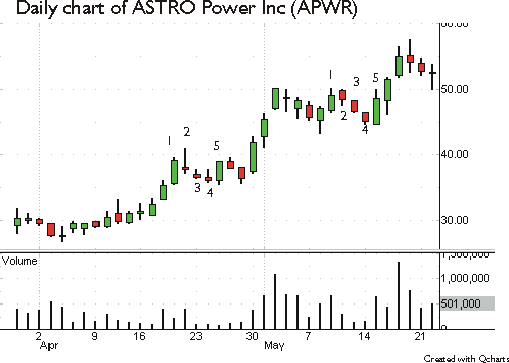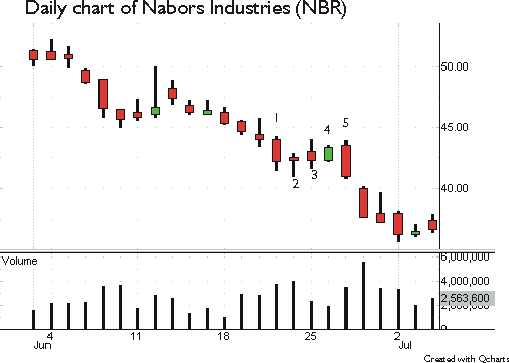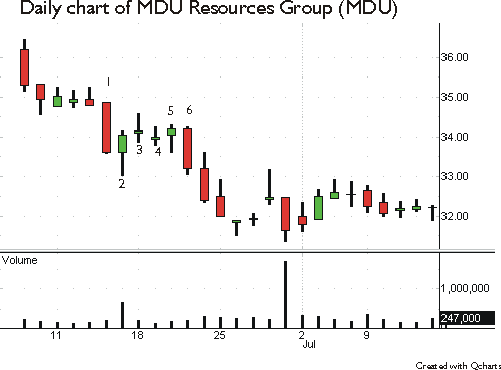Today’s Trading Lesson From TradingMarkets
Editor’s Note:
Each night we feature a different lesson from
TM University. I hope you enjoy and profit from these.
E-mail me if you have any
questions.
Brice
In
Trending Markets, Use These Candlestick Continuation Patterns
By Tsutae Kamada
Â
If you want to be popular and respected among traders, call every
reversal point accurately. Warn traders when the top is forming, and inform
people to prepare for the bottom. If you can do that with pinpoint accuracy, I
guarantee that you will be a star. You will be the most sought-after person in
the trading community.Â
The Engulfing pattern, the Harami pattern, the Shooting Star, Morning and
Evening Star patterns — all these reversal candlestick patterns are supposed to
be excellent ways of detecting important bottoms and tops. More than a few years
ago, I read a report that said, “The candlestick charting technique does not
have unfair advantages over other charting methods. The accuracy of candlestick
charting technique is 50/50, or worse, depending on which market you are trading
in.” I’m not trying to discredit candlesticks. In fact, I encourage you to use
them as part of your decision-making process. It is always wise to get as many
confirmations as possible before committing your money. Remember, multiple
signals are better than one signal. Â
Today, I want to talk about continuation patterns of candlesticks. As you know,
strong stocks cannot go up forever without taking a rest. They have to pull back
from their highs before resuming their uptrend. This is the main idea behind
continuation candle patterns. They are designed to detect when strong or weak
stocks are taking a rest. It is just like the popular 1-2-3-4.Â
Let’s begin with the
Rising Three Method.
The
Rising Three Method
On this daily chart of ASTRO Power (AWPR),
I want you to focus on numbers 1 through 5. This is what the Rising Three Method
looks like. For it to be effective, some traders insist that Day 5’s close must
be higher than Day 1’s high, and Day 4’s low cannot go below the low of Day 1. I
don’t think this is really necessary, and do not wish to restrict myself too
much when I trade. Since this pattern consists of five candlesticks, I think
some leeway should be allowed.
First, we need to confirm a stock is in an uptrend. The number 1 bar must be an
up day with its open near the low and its close near the high. The numbers 2, 3,
and 4 are pullback bars with small real bodies, and the color of the real body
is not important. The number 5 bar is a bullish engulfing line that wraps almost
entirely the previous down bars. A conventional buy entry will be made when the
stock takes out the high of the number 5 bar. This is where I disagree. If you
are a follower of the 1-2-3-4 method, you would be a buyer of this stock on Day
5. You can safely buy this stock when it trades above the high of the number 4
bar. Â

The Falling Three MethodÂ
The opposite of the
Rising Three Method can be seen on this daily chart of Nabors Industries (NBR).
I would like you to take a look at numbers 1 through 5. The number 1 bar has to
be a down day with its open near the high and its close near the low. The
numbers 2, 3, and 4 are pullback bars with small real bodies. Some traders
demand that the color of the small real bodies be the opposite of Day 1. The
number 5 bar is a bearish engulfing line that almost wraps all prior three bars.
Your sell entry comes when the stock falls below the low of the number 5 day.
Again, if you are a typical pullback player, you would not wait that long. In
fact, you sell the stock when it trades below the low of the number 4 day.Â

I
want you to be a flexible trader.
In actual trading situations, as you know,
textbook-perfect shapes and patterns rarely develop. Here is a daily chart of
MDU Resources Group (MDU).
As you can see, it appears to be forming the Falling Three Method, but if you
count correctly, it has four small real bodies. The number 6 bar is a bearish
engulfing line that almost covers all previous four small bodies. Don’t be too
textbookish. Rather, be flexible. After all, a textbook is a textbook.

Good luck
and happy trading.
